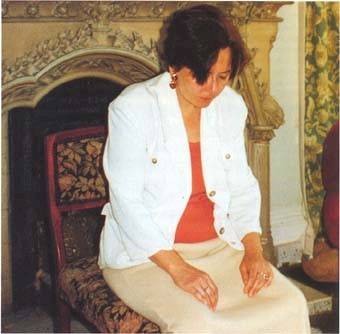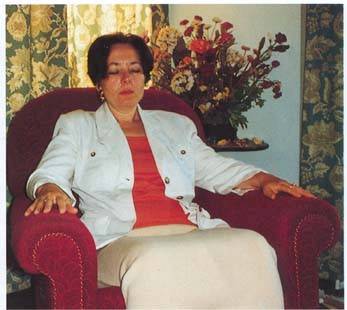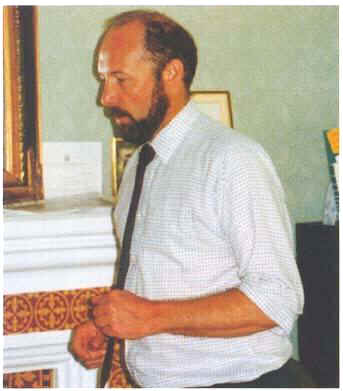Positive Health Online
Your Country

Autogenic Therapy - the best form of self-help
listed in mind matters, originally published in issue 22 - September 1997
The mind and the body and the spirit are all inter-related and interdependent. All holistic practitioners know the principle of this statement, and they all know that the human being's innate capacity for self-healing is largely untapped. Many therapies aim to address it by stimulation, whether by outside agents such as herbs and homoeopathy or by hands-on bodywork, of many differing kinds.

Figure 1 The Simple Sitting Position with inner voice repetition of the Standard Exercises
The mind and the body and the spirit are all inter-related and interdependent. All holistic practitioners know the principle of this statement, and they all know that the human being's innate capacity for self-healing is largely untapped. Many therapies aim to address it by stimulation, whether by outside agents such as herbs and homoeopathy or by hands-on bodywork, of many differing kinds.
But can we learn to activate our own self-righting mechanisms? Can we cause the healing capacity to work at our own command and directive, rather than giving that power to another person (a therapist)? Can we take charge of our own destiny in the way of managing our own stress on a daily basis, and even prevent the likelihood of serious illness?
The answer is 'Yes we can'.
Autogenic Therapy is a method of mental, meditative-type exercises, which bring about profound relaxation in mind and body. The word 'autogenic' means 'self-generating'. This can be a two-fold concept. First, the treatment is carried out by the client; autogenic exercises are applied by the self to the self. There is no 'middle-man' in the shape of a therapist except in the role of guide and support in the initial teaching of the method. Second, the result of practising the exercises is entirely spontaneous and unpredictable: the system of rebalance knows exactly what is required and will bring it about if left alone to do so.
So what is this all about?
In the 1920s, a German neuro-psychiatrist named Dr Johannes Schultz, became intrigued by the physiological implications of a person in a deeply relaxed state such as when under hypnosis, or when going to sleep. Taking the observations of researchers into the hypnotic state (the work of Vogt and Brodmann), Schultz constructed a set of simple auto-suggestions (mental exercises) incorporating those observations.
Over time these were developed into the Six Standard Exercises of AT which we know today: heaviness in the limbs, then warmth, focusing on the heartbeat or pulse, breathing, an idea of warmth in the abdomen, and coolness in the forehead. If these are the perceived sensation of mind and body in a deeply relaxed state, then Schultz simply made a conscious exercise of that perception.
Autogenic Therapy is a concept of auto-suggestion but it is not self-hypnosis.
Such innocent beginnings were in fact the discovery of an extremely powerful method of self-help. As Schultz developed the exercises and used them more widely among his acquaintances, colleagues and family, not to mention his patients, his results showed the extraordinary power of mind and body influencing self-healing processes.
It would seem, as Schultz's colleague Dr Wolfgang Luthe later propounded, that the human body is naturally 'programmed' to heal itself. (We already have proof of this, or broken bones would not heal, and we would never recover from serious illness or injury.) The state of homoeostasis (the natural balance of function in mind and body) is a goal for which, all unawares, we constantly strive. The mind and body is always in a state of flux: finely tuning itself to correct imbalance here and there.
However, in general, our lifestyles impede this process. Too much attention is given to simply 'getting by' in life. We drive ourselves in ever-decreasing circles, winding up the spirals of tension, playing on our fears of failure, until eventually our weary selves encounter breakdown – either of mind or of body.
Practice of Autogenic Therapy
If we take on board the habit of regular practice of autogenic exercises, we can alter this spiralling pattern. Practising one exercise actively switches off the stress 'flight and fight' response for a few minutes, allowing rest, recuperation and repair. Practising several exercises in a day, every day, gradually educates the mind and body to react differently to situations or circumstances around us. Those few minutes in the 'autogenic state' as we often refer to it, or an 'altered state of consciousness', begin a process of healing which can lead to permanent changes in our physical health and emotional well-being.
The key to bringing about this change is the state of being passive. In any autogenic exercise two branches of passivity occur. First, the use of 'passive concentration' in the exercise; secondly, the attitude of being the 'passive observer' during practice. The combination of these aspects brings about an attitude of 'passive acceptance': the simple acknowledgement of the observations without judgement of 'good' or 'bad'.
The task of carrying out an exercise is carefully taught. No special clothing is required, and you can practise virtually anywhere – even in public transport or the loo at work! Adopt one of the recommended postures using an ordinary dining-type chair or armchair, or lying down on your back. Use the phrase of the exercise (eg. 'My Arm is Heavy') as a thought repetition. Casually observe any response noticeable during the exercise period.
Passive concentration is the frame of mind we adopt in carrying out the task. Usually the first exercise is a simple one of taking the attention to one limb, with closed eyes, and repeating the relevant phrase as a thought. The specified 'autogenic posture' allows complete relaxation in the body, and elimination of distractions both within and outside our conscious awareness. The next task is to allow a similar 'letting go' in the mind. The focusing on the limb, without any idea of making something happen or striving for a result, while repeating the thought-suggestion, is passive concentration.

Figure 2 The Armchair Position with inner voice repetition of the Standard Exercises.
The second branch of passivity, being the passive observer, allows the occurrence of small responses to the exercises to be casually noted without expectation or judgement. These observations will either be a 'training symptom' or an 'autogenic discharge'.

Figure 3 The Anxiety or Worrying Intentional Exercise with vocalisation whilst wallowing/pacing around.
Autogenic Discharge
A training symptom may simply take the form of the relevant limb feeling heavy or warm, ie. having a direct relation to the thought-suggestion (or exercise formula) being used. Sometimes a paradoxical feeling can occur, eg. a feeling of lightness, while using the suggestion of heaviness.
The autogenic discharge has a different connotation. Every event in our lives is imprinted somewhere in the memory. Perhaps 98% of the memory is beyond our conscious recall. However, when a person begins to use autogenic training for the first time, the self-righting system will, according to its own programme, tap into the memory and gently bring material to the surface.
There are literally thousands of possibilities in terms of types and degrees of severity of discharge. To attempt to list them would be pointless, but common ones are slight twitching of muscles in the limbs, much like we notice as we go to sleep; borborygmi or stomach rumbles; coughing; salivating; slight aches and pains we might recognise as being related to past illness or injury. This is an immensely important area of the therapy. The self-righting process, of bringing mind and body back to functioning in homeostasis, consists first of allowing an autogenic discharge, then acknowledging it, and finally letting it go. You may like to perceive this idea as a cleansing process.
In addition to practising exercises, the person also needs to keep a diary, so a record of the process is made. This ensures that practice is carried out according to recommendations, and encourages the participant to take proper account of the effects of exercises. The diary helps the therapist to advise appropriately, but the participant themselves needs the diary as the place to acknowledge these passing observations.
So what are the procedures for someone wanting to learn AT?
The method is taught over a period of time – usually 8–10 weeks. Lessons are either individual or in small groups of 6–8 people, in which case they last for about 1½ hours. The first stage after contacting your therapist is to have an initial consultation, usually of an hour's duration, where a health history is taken, with discussion about life events. This gives an opportunity to assess the current situation and plan the course, if necessary, according to the needs of the person. A choice is made as to the preference of learning AT individually or in a group.
Each week a new exercise is added to the programme, until all six standard exercises have been learned. In addition to the standard exercises it is possible to construct Personal and Motivational Formulae according to specific needs of the person. These take the form of positive affirmations, and are used to change a habit, or some attitude to life circumstances. They are also used to heal physical or emotional wounds.
Alongside the autogenic exercises, in the UK we teach Intentional Exercises. These are a relatively recent addition to the autogenic programme: the brainchild of Dr Wolfgang Luthe, and the result of his research and development of AT in Canada during the 1970s.
Luthe was concerned that people stopped practice of AT exercises, and did not complete the programme. This action was usually accompanied by the awareness of uncomfortable symptoms which the practice of AT seemed to exacerbate. His research concluded that many of these symptoms were emotionally-based, that the brain was somatising the need to cry, or the need to express anger and anxiety, and registered no outlet for these. Our modern culture has usually educated out of us our natural forms of expression of feelings. The Intentional Exercises help us to recognise and own our emotions, and are an integral part of the learning procedure – an excellent aid to the whole process of self-righting. The message is: it is all right to cry, and we can re-learn the art if we have forgotten how. This branch of the method also gives us permission to be human and normal!
Clinical Applications of Autogenic Therapy
Autogenic Therapy (or Autogenic Training as it is often known) has spread to many parts of the world, and over 3,000 research papers have shown its efficacy. AT can have a positive effect on many chronic health problems, while preventing invasive treatments for many acute symptoms. Conditions such as asthma respond particularly well. Many asthma sufferers are aware that their symptoms are worse when under stress, so helping cope with lifestyle issues will indirectly help their asthma. In addition, the person knows that they have a tool which can stimulate the system to adjust itself, so when an asthma attack is imminent, it may be nipped in the bud by doing an exercise.
Similarly with headaches: studies are currently going on in Hertfordshire to see how effective AT is in helping migraine. Many sufferers have reported the ability to stop serious attacks, which brings their symptoms under their own control. This fact alone addresses the constant fear of attack. One lady had not had a holiday for years, due to the frequency and severity of her headaches (her GP often administered intra-muscular Pethidine for them). At the end of a 9-week course of AT, she had booked her holiday, and was intending to pack the headaches in her suitcase and take them with her (she wasn't yet sure about leaving them behind)! This difference in attitude alone plays a large part in healing.
Other conditions which have shown benefit include high or low blood pressure, irritable bowel syndrome, colitis, arthritis, muscular pain and tension, and bladder disorders.
Research has shown significant reductions in high cholesterol levels, self-adjusting thyroid levels from too high or too low; and reduction in need for diabetic medication. Although if the diabetes is insulin controlled, the likelihood of permanent positive change is small, depending on the level of pancreatic function.
Psychological problems involving anxiety and panic, aggression, and unresolved grief reactions can all improve. Insomnia is one of the common-most needs for taking medication, and is often cleared up after only a few weeks. A business man in his mid-40s, had never slept properly since childhood. ('I thought everyone stood by their bedroom windows wondering about the stars. It wasn't until I saw my wife sleeping uninterrupted every night that I realised I had a problem.') Since AT is not always an instant panacea for all ills, I hesitated to be too optimistic for this gentleman. But his progress with the method was well-applied and gentle, and he surprised himself by giving up his very long-term medication in a matter of weeks.
Perhaps the most significant feedback is the realisation of improved general health. People report fewer coughs and colds, or time off work for minor health concerns such as stress-related back-pain. This observation, coupled with the use of autogenics with sufferers of AIDS (which gives reduction in ARC, or AIDS-Related Complex, symptoms, and improved quality of life) implies that practising AT boosts the immune system. A client of mine learned AT four years ago at a time when he was plagued by recurring throat infections and flu-like symptoms which kept him off work for at least two weeks in every six. A year later he was disappointed to have had to take time off work for the first time since using AT. But his observation was that his recovery from that bout of illness was much faster than previously.
A healthy and strong immune system is vital for the prevention of cancer: its quick and efficient metabolism and excretion of the cancer cells which are present in all of us plays a large part in our well-being.
|
Let Autogenics take the strain To benefit from AT, you must be taught the technique individually. However, Jane Bird has devised some relaxation tips to give you an idea of its philosophy |
Personal Results of Autogenic Therapy
Most reports from clients emphasise how much better they feel both within themselves and about themselves. One woman recently told me: "My emotional metabolism has slowed down. I'm still upset at times, but I don't overreact. My whole life feels much more under control". Hand-in-hand with these ideas come reports of greater coping ability, and increased self-awareness and self-confidence.
Of course, you don't have to be ill to benefit from learning AT. Many people have found that creative ability and ideas begin to flow; sportsmen improve their performance; musicians, artists and writers take on a different attitude to their work. In industry, AT is being increasingly used as an effective Stress Management technique.
The subtleties of AT can at times be frustrating. The exercises are so easy to practise that they can feel difficult. Our Westernised culture is always seeking a result, and proof that what we do is effective. If we get over-concerned with wishing to do AT exercises 'right' we can impede the very process we are trying to enhance. The secret is to develop what Luthe called the 'casual nonchalant approach'. So there is a curious paradox: on the one hand we are encouraging our self-awareness; on the other we don't pay it too much attention, just enough.
In a short space of time, then, a life can change. Learning AT in a few weeks is a superb short-term therapy which is either a complete entity of its own, or the beginning of further personal development. Once you have learned AT it is yours for life – to use in any way which is suitable in your lifestyle.
When counsellors, medical practitioners or psychotherapists learn AT for themselves and appreciate its potential, they very often come forward to train as autogenic therapists to add to their existing modes of treatment. The autogenic therapist gains most from their own experiential use of AT. From that, he/she will develop the 'light touch', to be the non-interfering witness on behalf of the client, which attitude is eventually taken on by the client themselves. So AT is never therapist-dependent.
Further Information
The British Association for Autogenic Training and Therapy, founded in 1984, is a registered charity formed for the purpose of training therapists and maintaining professional standards. BAFATT is a member of the UKCP (United Kingdom Council for Psychotherapy), EAP (European Association of Psychotherapy), and ICAT (The International Committee for Autogenic Training). Full Membership of BAFATT is gained after the part-time three-year professional training course: following through the recommended lecture modules, tutorial seminars, assisting in a training group, preparing case-studies, and a final exam.
If you are interested in knowing more about AT, and finding your local practitioner, please send a stamped self-addressed envelope to: BAFATT, c/o Royal London Homoeopathic Hospital NHS Trust, Great Ormond Street, London, WC1N 3HR. Telephone enquiries are not available.
The only truly effective way to find out what AT really feels like is to learn it yourself. So versatile (practice can be a few seconds or twenty minutes with almost any variation in between): it will be the best friend you ever made.
References:
Schultz, Dr Johannes H & Luthe, Dr Wolfgang Autogenic Therapy Vols 1 – 6. Publisher: Grune & Stratton, New York, 1969
O'Donovan, Dr J. B. Autogenic Training in Organic Illness. Publisher: J. B. O'Donovan, Chichester, 1989
Comments:
-
No Article Comments available